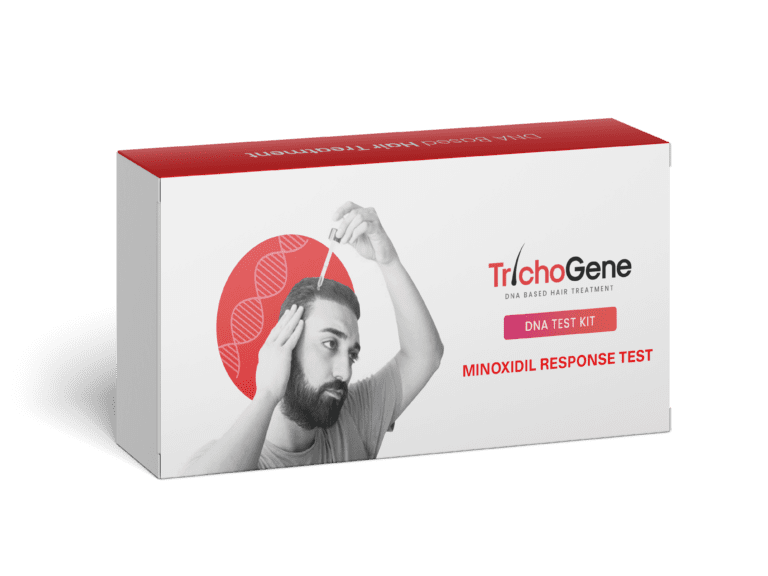Minoxidil Response Test
See if Minoxidil Works for You
Discover the pioneering and exclusive at-home pharmacogenetics test that revolutionizes how you address hair loss.
Say goodbye to uncertainty and find a personalized solution that truly works for you.


Understanding SULT1A1 and Minoxidil Response
What Is the Minoxidil Mechanism of Action for Hair Growth?
Minoxidil's mechanism of action in treating hair loss, particularly androgenetic alopecia (AGA), involves several processes, including its conversion into its active form and its interaction with various enzymes in the scalp. One of the key enzymes involved in predicting minoxidil response is the sulfotransferase enzyme, specifically SULT1A1.
Minoxidil Activation: When applied topically to the scalp, minoxidil undergoes enzymatic conversion into its active form, minoxidil sulfate. This conversion is primarily catalyzed by the sulfotransferase enzymes present in the scalp tissue.
Minoxidil Sulfate Formation: Minoxidil sulfate is the active metabolite responsible for exerting the vasodilatory effects on the blood vessels surrounding the hair follicles. This vasodilation increases blood flow to the hair follicles, delivering essential nutrients and oxygen, and promoting hair growth.
Role of SULT1A1: Sulfotransferase enzymes, particularly SULT1A1, play a crucial role in the conversion of minoxidil into its active form. SULT1A1 is highly expressed in human scalp tissues and is responsible for sulfating various substrates, including minoxidil. The activity of SULT1A1 enzyme determines the rate and extent of minoxidil conversion to minoxidil sulfate.
Predicting Minoxidil Response: Research suggests that the activity levels of sulfotransferase enzymes, such as SULT1A1, in the scalp tissue may influence an individual's response to minoxidil treatment. Higher levels of SULT1A1 activity may lead to more efficient conversion of minoxidil into its active form, resulting in enhanced vasodilatory effects and improved hair growth response to minoxidil therapy.
Clinical Significance: Assessing the expression and activity of sulfotransferase enzymes, particularly SULT1A1, may serve as a potential biomarker for predicting individual responsiveness to minoxidil treatment. Individuals with higher SULT1A1 activity levels may be more likely to respond favorably to minoxidil therapy, while those with lower activity levels may have a diminished response.
In summary, sulfotransferase enzymes, such as SULT1A1, play a crucial role in minoxidil activation and its efficacy in treating hair loss. Understanding the activity levels of these enzymes may help predict individual responsiveness to minoxidil therapy and tailor treatment approaches for optimal outcomes in individuals with AGA.
References:
- McCoy J, Goren A, Naccarato T, Kovacevic M, Situm M, Skudar VL, et al. Identification of thesulfotransferase iso-enzyme primarily responsible for the bio-activation of topical minoxidil. J BiolRegulHomeost Agents. 2019;33(3):817-9.
- Anderson RJ, Kudlacek PE, Clemens DL. Sulfation of minoxidil by multiple human cytosolicsulfotransferases. Chem Biol Interact. 1998;109(1-3):53-67.
- van Zuuren EJ, Fedorowicz Z. Interventions for Female Pattern Hair Loss. JAMA Dermatol.2017;153(3):329-30.
- Goren A, Shapiro J, Roberts J, McCoy J, Desai N, Zarrab Z, et al. Clinical utility and validity ofminoxidil response testing in androgenetic alopecia. Dermatol Ther. 2015;28(1):13-6
- Ramos PM, Sinclair RD, Kasprzak M, Miot HA. Minoxidil 1 mg oral versus minoxidil 5% topicalsolution for the treatment of female-pattern hair loss: A randomized clinical trial. J Am Acad Dermatol.2020;82(1):252-3.
- Jimenez-Cauhe J, Saceda-Corralo D, Rodrigues-Barata R, Hermosa-Gelbard A, Moreno-ArronesOM, Fernandez-Nieto D, et al. Effectiveness and safety of low-dose oral minoxidil in male androgenetic alopecia. J Am Acad Dermatol. 2019;81(2):648-9.
- Ramos PM, Goren A, Sinclair R, Miot HA. Oral minoxidil bio-activation by hair follicle outer rootsheath cell sulfotransferase enzymes predicts clinical efficacy in female pattern hair loss. J EurAcadDermatol Venereol. 2020;34(1):e40-e1.
- Raftogianis RB, Wood TC, Otterness DM, Van Loon JA, Weinshilboum RM. Phenol sulfotransferasepharmacogenetics in humans: association of common SULT1A1 alleles with TS PST phenotype. BiochemBiophys Res Commun. 1997;239(1):298-304.
- Ozawa S, Tang YM, Yamazoe Y, Kato R, Lang NP, Kadlubar FF. Genetic polymorphisms in humanliver phenol sulfotransferases involved in the bioactivation of N-hydroxy derivatives of carcinogenicarylamines and heterocyclic amines. Chem Biol Interact. 1998;109(1-3):237-48.
- Raghad N, Al-Gazally ME, Ewahd W. A" Assessment the Effect of Different Genotypes ofSulfotransferase 1A1 Gene on the Response to Monoxide in Patients with Androgenic Alopecia. Journal of Global Pharma Technology. 2017;10(9):31-6.